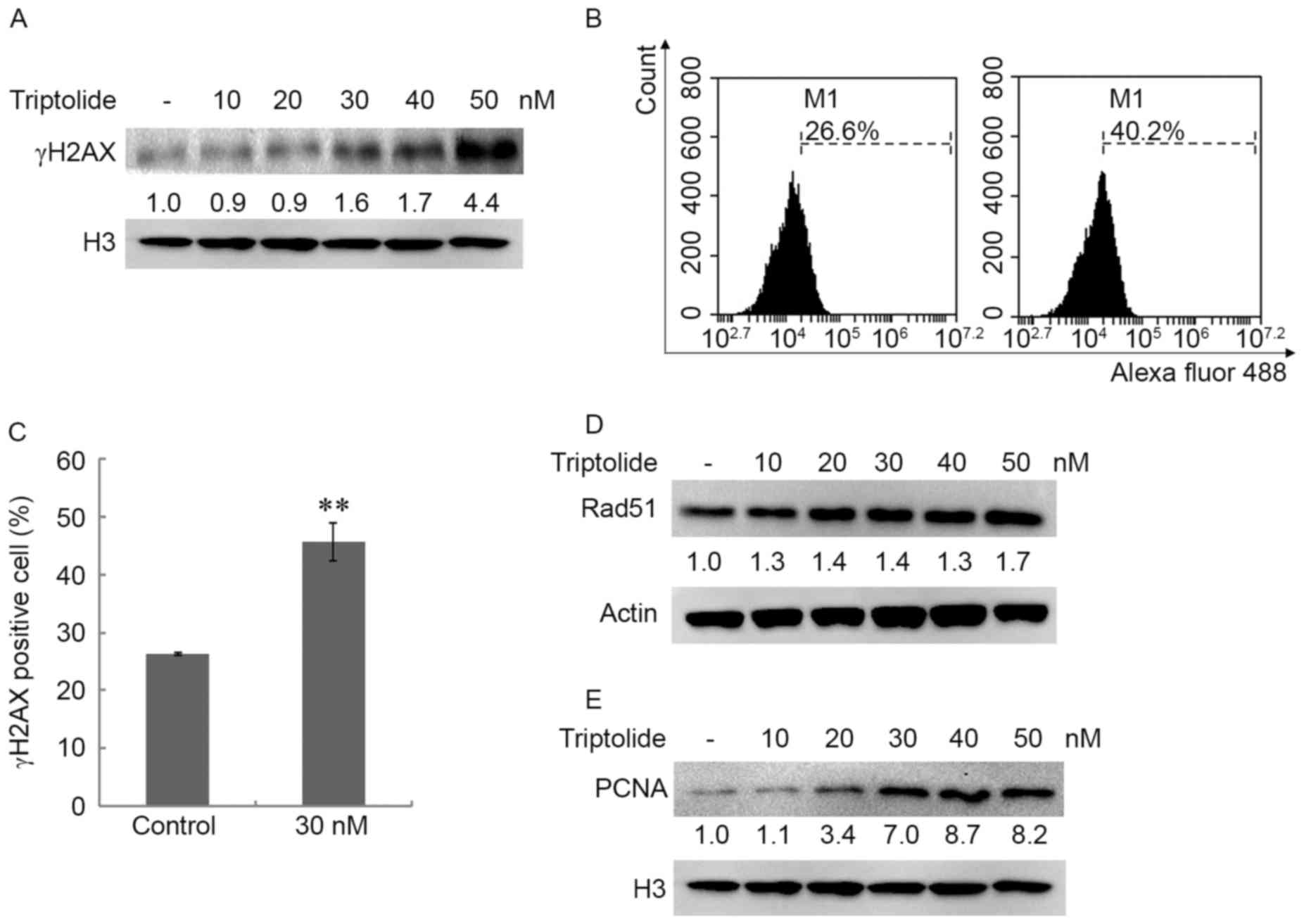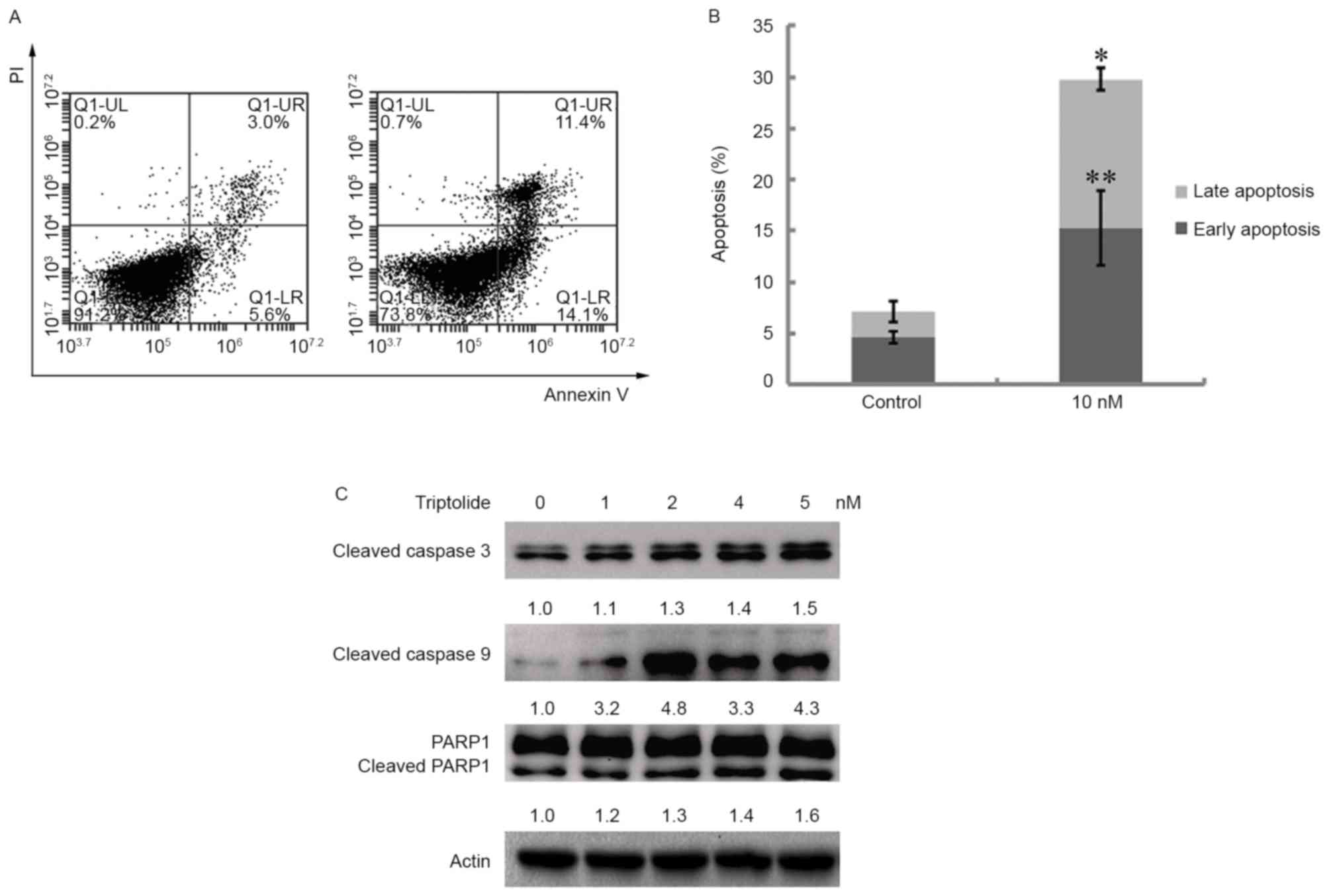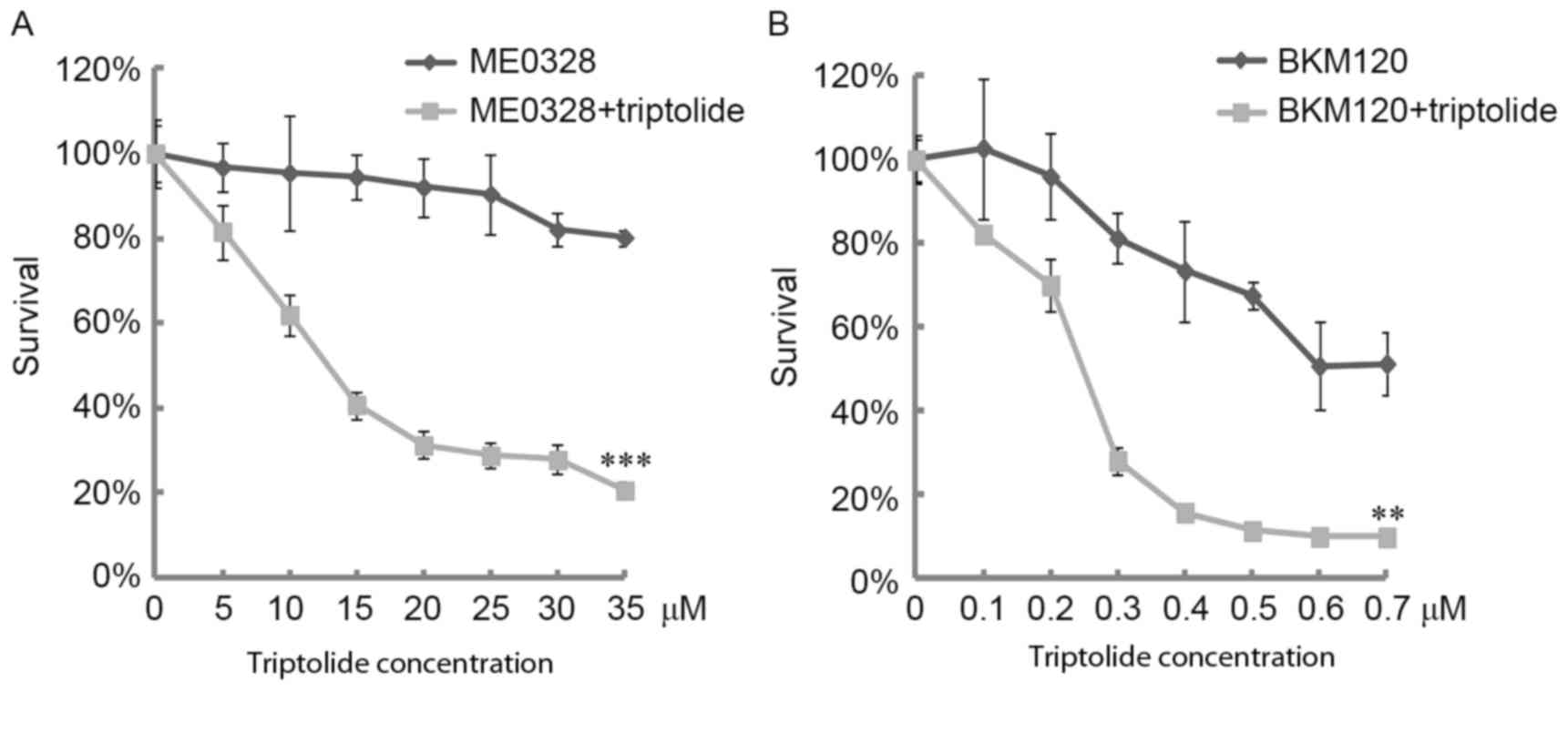|
1
|
Canter PH, Lee HS and Ernst E: A
systematic review of randomised clinical trials of Tripterygium
wilfordii for rheumatoid arthritis. Phytomedicine. 13:371–377.
2006. View Article : Google Scholar : PubMed/NCBI
|
|
2
|
Cheng X, Shi W, Zhao C, Zhang D, Liang P,
Wang G and Lu L: Triptolide sensitizes human breast cancer cells to
tumor necrosis factor-α-induced apoptosis by inhibiting activation
of the nuclear factor-κB pathway. Mol Med Rep. 13:3257–3264. 2016.
View Article : Google Scholar : PubMed/NCBI
|
|
3
|
Ding X, Zhou X, Jiang B, Zhao Q and Zhou
G: Triptolide suppresses proliferation, hypoxia-inducible factor-1α
and c-Myc expression in pancreatic cancer cells. Mol Med Rep.
12:4508–4513. 2015. View Article : Google Scholar : PubMed/NCBI
|
|
4
|
Li J, Zhu W, Leng T, Shu M, Huang Y, Xu D,
Qiu P, Su X and Yan G: Triptolide-induced cell cycle arrest and
apoptosis in human renal cell carcinoma cells. Oncol Rep.
25:979–987. 2011.PubMed/NCBI
|
|
5
|
Yan X, Ke XX, Zhao H, Huang M, Hu R and
Cui H: Triptolide inhibits cell proliferation and tumorigenicity of
human neuroblastoma cells. Mol Med Rep. 11:791–796. 2015.
View Article : Google Scholar : PubMed/NCBI
|
|
6
|
Zhu W, Hu H, Qiu P and Yan G: Triptolide
induces apoptosis in human anaplastic thyroid carcinoma cells by a
p53-independent but NF-kappaB-related mechanism. Oncol Rep.
22:1397–1401. 2009.PubMed/NCBI
|
|
7
|
Yang SX, Gao HL, Xie SS, Zhang WR and Long
ZZ: Immunosuppression of triptolide and its effect on skin
allograft survival. Int J Immunopharmacol. 14:963–969. 1992.
View Article : Google Scholar : PubMed/NCBI
|
|
8
|
Jiang QW, Cheng KJ, Mei XL, Qiu JG, Zhang
WJ, Xue YQ, Qin WM, Yang Y, Zheng DW, Chen Y, et al: Synergistic
anticancer effects of triptolide and celastrol, two main compounds
from thunder god vine. Oncotarget. 6:32790–32804. 2015. View Article : Google Scholar : PubMed/NCBI
|
|
9
|
Reno TA, Kim JY and Raz DJ: Triptolide
inhibits lung cancer cell migration, invasion, and metastasis. Ann
Thorac Surg. 100:1817–1825. 2015. View Article : Google Scholar : PubMed/NCBI
|
|
10
|
Liu J, Shen M, Yue Z, Yang Z, Wang M, Li
C, Xin C, Wang Y, Mei Q and Wang Z: Triptolide inhibits
colon-rectal cancer cells proliferation by induction of G1 phase
arrest through upregulation of p21. Phytomedicine. 19:756–762.
2012. View Article : Google Scholar : PubMed/NCBI
|
|
11
|
Brincks EL, Kucaba TA, James BR, Murphy
KA, Schwertfeger KL, Sangwan V, Banerjee S, Saluja AK and Griffith
TS: Triptolide enhances the tumoricidal activity of TRAIL against
renal cell carcinoma. FEBS J. 282:4747–4765. 2015. View Article : Google Scholar : PubMed/NCBI
|
|
12
|
Jao HY, Yu FS, Yu CS, Chang SJ, Liu KC,
Liao CL, Ji BC, Bau DT and Chung JG: Suppression of the migration
and invasion is mediated by triptolide in B16F10 mouse melanoma
cells through the NF-kappaB-dependent pathway. Environ Toxicol.
31:1974–1984. 2015. View Article : Google Scholar : PubMed/NCBI
|
|
13
|
Titov DV, Gilman B, He QL, Bhat S, Low WK,
Dang Y, Smeaton M, Demain AL, Miller PS, Kugel JF, et al: XPB, a
subunit of TFIIH, is a target of the natural product triptolide.
Nat Chem Biol. 7:182–188. 2011. View Article : Google Scholar : PubMed/NCBI
|
|
14
|
Westerheide SD, Kawahara TL, Orton K and
Morimoto RI: Triptolide, an inhibitor of the human heat shock
response that enhances stress-induced cell death. J Biol Chem.
281:9616–9622. 2006. View Article : Google Scholar : PubMed/NCBI
|
|
15
|
Breslin C, Hornyak P, Ridley A, Rulten SL,
Hanzlikova H, Oliver AW and Caldecott KW: The XRCC1
phosphate-binding pocket binds poly (ADP-ribose) and is required
for XRCC1 function. Nucleic Acids Res. 43:6934–6944. 2015.
View Article : Google Scholar : PubMed/NCBI
|
|
16
|
Caldecott KW, McKeown CK, Tucker JD,
Ljungquist S and Thompson LH: An interaction between the mammalian
DNA repair protein XRCC1 and DNA ligase III. Mol Cell Biol.
14:68–76. 1994. View Article : Google Scholar : PubMed/NCBI
|
|
17
|
Sossou M, Flohr-Beckhaus C, Schulz I,
Daboussi F, Epe B and Radicella JP: APE1 overexpression in
XRCC1-deficient cells complements the defective repair of oxidative
single strand breaks but increases genomic instability. Nucleic
Acids Res. 33:298–306. 2005. View Article : Google Scholar : PubMed/NCBI
|
|
18
|
Critchlow SE, Bowater RP and Jackson SP:
Mammalian DNA double-strand break repair protein XRCC4 interacts
with DNA ligase IV. Curr Biol. 7:588–598. 1997. View Article : Google Scholar : PubMed/NCBI
|
|
19
|
Baumann P and West SC: Role of the human
RAD51 protein in homologous recombination and double-stranded-break
repair. Trends Biochem Sci. 23:247–251. 1998. View Article : Google Scholar : PubMed/NCBI
|
|
20
|
Bravo R: Synthesis of the nuclear protein
cyclin (PCNA) and its relationship with DNA replication. Exp Cell
Res. 163:287–293. 1986. View Article : Google Scholar : PubMed/NCBI
|
|
21
|
Altmeyer M, Messner S, Hassa PO, Fey M and
Hottiger MO: Molecular mechanism of poly(ADP-ribosyl)ation by PARP1
and identification of lysine residues as ADP-ribose acceptor sites.
Nucleic Acids Res. 37:3723–3738. 2009. View Article : Google Scholar : PubMed/NCBI
|
|
22
|
El-Khamisy SF, Masutani M, Suzuki H and
Caldecott KW: A requirement for PARP-1 for the assembly or
stability of XRCC1 nuclear foci at sites of oxidative DNA damage.
Nucleic Acids Res. 31:5526–5533. 2003. View Article : Google Scholar : PubMed/NCBI
|
|
23
|
Herceg Z and Wang ZQ: Functions of
poly(ADP-ribose) polymerase (PARP) in DNA repair, genomic integrity
and cell death. Mutat Res. 477:97–110. 2001. View Article : Google Scholar : PubMed/NCBI
|
|
24
|
Javle M and Curtin NJ: The role of PARP in
DNA repair and its therapeutic exploitation. Br J Cancer.
105:1114–1122. 2011. View Article : Google Scholar : PubMed/NCBI
|
|
25
|
Schreiber V, Amé JC, Dollé P, Schultz I,
Rinaldi B, Fraulob V, Ménissier-de Murcia J and de Murcia G:
Poly(ADP-ribose) polymerase-2 (PARP-2) is required for efficient
base excision DNA repair in association with PARP-1 and XRCC1. J
Biol Chem. 277:23028–23036. 2002. View Article : Google Scholar : PubMed/NCBI
|
|
26
|
Follo MY, Manzoli L, Poli A, McCubrey JA
and Cocco L: PLC and PI3K/Akt/mTOR signalling in disease and
cancer. Adv Biol Regul. 57:10–16. 2015. View Article : Google Scholar : PubMed/NCBI
|
|
27
|
D'Amato V, Rosa R, D'Amato C, Formisano L,
Marciano R, Nappi L, Raimondo L, Di Mauro C, Servetto A, Fusciello
C, et al: The dual PI3K/mTOR inhibitor PKI-587 enhances sensitivity
to cetuximab in EGFR-resistant human head and neck cancer models.
Br J Cancer. 110:2887–2895. 2014. View Article : Google Scholar : PubMed/NCBI
|
|
28
|
Hu Y, Guo R, Wei J, Zhou Y, Ji W, Liu J,
Zhi X and Zhang J: Effects of PI3K inhibitor NVP-BKM120 on
overcoming drug resistance and eliminating cancer stem cells in
human breast cancer cells. Cell Death Dis. 6:e20202015. View Article : Google Scholar : PubMed/NCBI
|
|
29
|
Valdiglesias V, Giunta S, Fenech M, Neri M
and Bonassi S: γH2AX as a marker of DNA double strand breaks and
genomic instability in human population studies. Mutat Res.
753:24–40. 2013. View Article : Google Scholar : PubMed/NCBI
|
|
30
|
Garcia-Canton C, Anadón A and Meredith C:
γH2AX as a novel endpoint to detect DNA damage: Applications for
the assessment of the in vitro genotoxicity of cigarette smoke.
Toxicol In Vitro. 26:1075–1086. 2012. View Article : Google Scholar : PubMed/NCBI
|
|
31
|
Liu J, Jiang Z, Liu L, Zhang Y, Zhang S,
Xiao J, Ma M and Zhang L: Triptolide induces adverse effect on
reproductive parameters of female Sprague-Dawley rats. Drug Chem
Toxicol. 34:1–7. 2011. View Article : Google Scholar : PubMed/NCBI
|













